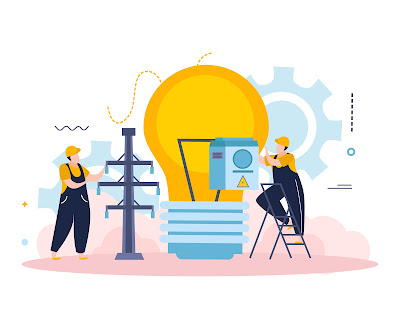Postingan update
- Dapatkan link
- X
- Aplikasi Lainnya
Nearly everyone is familiar with electricity. It causes the lights to turn on and comes out of the wall plugs in our homes. If you touch it, it might injure you. Why is that so? Why can touching a doorknob cause you to shock? Electricity can be seen in lightning. Why is that so?
Atoms are extremely tiny building blocks that make up everything in the universe. Even under a microscope, they are invisible due to their small size. Two different types of electric charge make up an atom. The positive charges are located in the center of the atoms, while the negative charges are found fluttering about the exterior. There are typically equal numbers of positive and negative charges. There is a negative companion for every positive charge.
However, occasionally, there are an excessive number of one form of charge. These supplementary fees look for a friend. These negative charges, known as electrons, are held loosely within the atom, making it simple for them to move around. We refer to this as electricity because of the moving electrons. Electricity comes in two flavors: static and current.
When you brush a balloon against your hair, static electricity causes your hair to stand up, and your doorknob can shock you. Electrons are mechanically moved around in static electricity (i.e. by someone rubbing two things together). Extra charge is scraped from the carpet and accumulates on your body when you drag your feet across the carpet.
All the charge wants to leave you when you touch a doorknob and go to the doorknob. You get a jolt as the electrons leave you after seeing a spark.
The cause of lightning is static electricity. Negatively charged particles can accumulate in a cloud during a thunderstorm. Electrons are attracted to one another and try to keep as far apart from one another as they can.
Since it's the biggest item nearby, the furthest they can be from one another is if they dive into the ground. We observe lightning as the electrons leap to the group. It like a large spark. Benjamin Franklin learned that lightning poses a significant risk. More than 20 million Volts are in lightning!
Electricity in current electricity must circulate in a circuit, a closed loop. Anywhere that the loop is interrupted prevents electricity from flowing through. Like blood in the body, this. The heart pumps blood through your arteries, and it finally returns to the heart through veins.
Electric charges serve as the blood in a circuit, and the wires serve as the arteries and veins. There is a certain amount of energy in electric charges. Voltage is the term for this energy's measurement (Volts). Your wall outlet has roughly 120 Volts, but a flashlight battery has about 1 1/2 Volts. A current is a flow of electrons via a circuit. When a strong current of electrons, or current, runs through your body, you could get an electric shock.
Something, such as a battery, must push the electrons in a circuit. The additional positive charges are located when a + sign is present on one end of a battery. There are additional negative charges at the opposite end, where there is a - symbol (electrons).
The electrons rush across the wires when we turn on a flashlight to reach the positive charges. They traverse the wire in the light bulb as they move along. Light is produced via a very hot thin wire inside the light bulb.
- Dapatkan link
- X
- Aplikasi Lainnya


Komentar